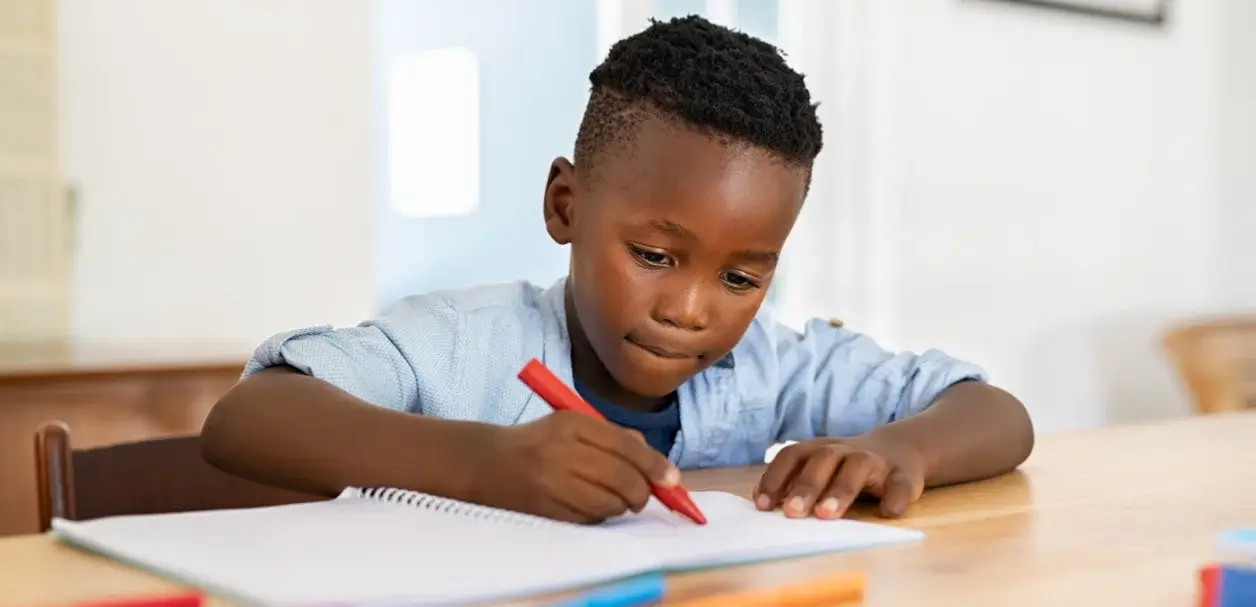Development from 4 to 5 Years
Little ones at this point typically can introduce themselves with first name and last, sing a song or nursery rhyme by heart, and tell a story of their own. Ideally, 4-year-olds are also well aware of cause and effect and have developed a good bit of sophistication around language and books. They begin comparing and contrasting favorite characters in different books. They come to see books as sources for answers to questions about the world, like what are clouds? and why does it rain?
It’s time to build some print awareness by talking to your child about how books work, how print conveys meaning, and what words look like. These are vital lessons, because before a child can read print, they must notice it.
Sprinkle in a few comments (max) before or during reading that direct your child’s attention to how books are organized and how print mirrors spoken language. Use your finger to point to letters and words, which helps them connect the marks on the page with the speech they hear and understand.
Select 4-to-5-Year Milestones & Targets
Oral Language
- Uses four-word sentences, like Look at the dog.
- Uses thousands of words and carries on conversations
- Asks wh- questions: why, where, what, when, who
- Answers why, how, and would you questions
- Refers to quantities
- Uses conjunctions, like when, so, if, because
Speech-Sound Awareness
- Recognizes sounds that match and words that begin or end with the same sounds
- Recognizes and produces rhyming words
- Distinguishes, blends, and segments separate syllables in spoken words
- Recognizes single sounds and combinations of sounds
Print Awareness
- Understands that print carries meaning
- Knows print is used for many purposes
Alphabetic Knowledge
- Distinguishes letters from other symbols
- Identifies their own name in print
- Names 15 to 26 upper- and lowercase letters
- Identifies similarities and differences among letters
Emergent Writing
- Forms letters
- Writes their own name
Book Behavior
- Listens to longer stories
- Retells familiar stories
- Understands cause and effect
Development from 5 to 7 Years
By 6 years old, kids typically speak clearly, tell stories with complete sentences, use the future tense, and say their own full name and address. They can count past ten, draw a person with several body parts, and copy triangles and other shapes. They also know a good deal about everyday life, from food to money.
But real differences in their literacy skills become obvious (to them and us) at this point, too. Elementary school classrooms often put reading and writing on display in ways that can’t help but highlight student variations. Everything from the reading group they’re placed in to the work displayed on the bulletin board exposes the differences.
It can be agonizing for parents to hear about the social drama playing out in the name of education—tales of one child being put “on the computer” because they can’t read, another
checking out the same baby book from the classroom library every day because that’s what’s on “their level,” and yet another signing their name with a scribble that’s different every time.
Yet all these kids are on their own unique paths to reading. We just need to clearly identify where they are, so that we can deliver the right experiences, instruction, and additional tools to keep them forging ahead. A few quick definitions, based on what science reveals about how beginners learn to read words in and out of context, will help.
- Prereaders rely on visuals alone to make sense of words. They may recognize a word within the context of a logo—say, Nike or Target—but they are unable to read those same words in plain type without the contextual clues of color or location. They do not yet use letter-sound cues to read or write.
- Beginning or emergent readers, sometimes called partial alphabetic readers, are beginning to apply what they know about letters and sounds to read and write. They demonstrate partial knowledge of how letters map to sounds but can’t yet decode unfamiliar words. They spell phonetically (duz for does, for example).
- Readers have full command of letter-sound correspondences, can decode unfamiliar words, and spell from memory. They’ve forged solid knowledge of the spellings, pronunciations, and meanings of many words through deep experience of hearing, saying, spelling, and understanding these.
Select 5-to-7-Year Milestones & Targets
Oral Language
- Retells stories in sequential order
- Talks about events
- Uses a range of adverbs and adjectives
- Asks and answers complex questions
- Gives directions
Speech-Sound Awareness
- Isolates, identifies, and categorizes individual speech sounds
- Blends individual speech sounds
- Segments individual speech sounds
- Deletes, adds, and substitutes individual speech sounds
Print Awareness
- Tracks print from left to right
Alphabetic Knowledge
- Recognizes an increasing number of upper- and lowercase letters
- Produces letter forms in writing or with materials like Play-Doh
- Matches uppercase and lowercase letters
Emergent Writing
- Writes full name
- Organizes writing from left to right
Phonics/Spelling
- Connects letters to their sounds
- Sounds out words
- Spells phonetically
- Reads and writes simple sentences
- Correctly spells frequently used words
Book Behavior
- Reads independently
Edited and reprinted with permission from Reading for Our Lives by Maya Payne Smart, published by AVERY, an imprint of Penguin Publishing Group, a division of Penguin Random House, LLC.
Copyright © 2022 by Maya Payne Smart.
Get Reading for Our Lives: A Literacy Action Plan from Birth to Six
Learn how to foster your child’s pre-reading and reading skills easily, affordably, and playfully in the time you’re already spending together.
Get Reading for Our Lives


